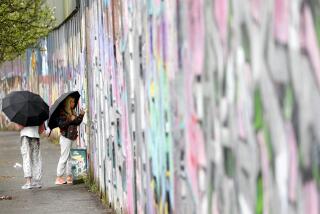A human face on the war in Iraq
- Share via
EVEN by 2004, filmmaker Philip Haas (“Angels and Insects”) felt himself becoming increasingly deadened to the barrage of news reports on the Iraq war.
“Fifty people killed one day,” Haas ticked off. “A car bomb the next. Soldiers injured.”
Haas thought it was time to put a human face on the conflict.
“There is a tradition of great war movies, but they are done years after the fact,” he said. “But to do something immediate and almost journalistic but at the same time fictional -- I thought would be interesting.”
A year later, Haas filmed “The Situation,” which opens Friday.
The drama, set in 2004, stars Connie Nielsen (“Gladiator”) as Anna, an American journalist embedded in Baghdad.
She opens a Pandora’s box when she decides to investigate an incident involving a group of American soldiers who throw two young Iraqi boys off a bridge in Samarra because they were attempting to cross it after curfew. One boy dies in the river.
At the same time, she finds herself pulling away from her lover, an American intelligence officer (Damian Lewis) and toward a handsome young Iraqi photographer (Mido Hamada). Their budding love affair offers only a brief respite from the horrors of the conflict, as Anna soon finds that her life is in danger.
“I think what is interesting about the film is that it shows what a disaster the occupation has been without alienating people who might have been in favor of it,” said Haas. “I am showing the film to Republicans now who are saying, ‘It explains [the war] to me.’ I showed it to an Iraqi war veteran’s group, who, regardless of their position [about the war], said: ‘It reflected our experience.’ ”
The film was written by Wendell Steavenson, a freelance journalist who had lived and reported in Iraq from 2003 until early 2005. Like the character Anna, Steavenson’s fiance is an Iraqi photographer.
Haas hired her to write the script after he read an article she had written for Granta magazine in which she followed a young jihadi around Baghdad who was trying to blow up American installations while his brother was working for the Americans.
Like her reel-life counterpart, Steavenson also found her life in jeopardy several times.
“In Kurdistan, a suicide bomb blew up some 100 yards in front of our car,” she said matter-of-factly. “I got shot at by, I think, the Iraqi army. We were on a highway in Iraq in January 2005, and suddenly gunfire erupted from all directions, and we had to take cover. There were bombs close to the hotel. I have had friends killed and kidnapped.”
Steavenson says she still finds it hard to describe just how “omnipresent and constant the violence was and certainly is now.”
NIELSEN realized when she got the role that she had to talk to as many journalists covering the war as possible “to get an all-over view because the experience from journalist to journalist is very different,” she said. (Among the reporters she talked to was The Times’ Louise Roug.)
“Everything that Wendell had described was confirmed again and again in my talks with everyone,” said Nielsen.
Haas decided to film the movie in Morocco because the countryside resembles Iraq.
“You couldn’t do it in Iraq,” he said, because it was too dangerous. “We wouldn’t be having this conversation now.” He added that “Morocco has a film infrastructure, so it was ideal.”
“We were all in the same nasty hotel,” said Nielsen. “There were times I had bugs crawling all over me because of where we were shooting. I got to tell you -- for me -- I wasn’t in Morocco; part of me was definitely in Iraq.”
Steavenson doesn’t see the civil war ending any time soon in Iraq, even with the influx of 20,000-plus troops that President George Bush plans to send.
“I don’t think there is any hope, to be blunt,” she said. “I don’t think the Americans nor the British are implementing any workable plan.
“It is a civil war that has sucked in other powers. There are competing interests and agendas, and unless you address those issues politically, then the violence will continue.”
She added: “Every neighborhood in Baghdad is a battleground. Pretty much most neighborhoods have been ethnically cleansed.
“The violence is every day and incredibly incursive and incredibly inclusive. There isn’t a single town in Iraq I would contend that hasn’t been touched....”
More to Read
Only good movies
Get the Indie Focus newsletter, Mark Olsen's weekly guide to the world of cinema.
You may occasionally receive promotional content from the Los Angeles Times.











